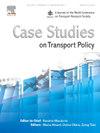Spatial variability of urban public transportation fare and the trigger factors in the Benin Metropolis, Nigeria
IF 3.3
Q3 TRANSPORTATION
引用次数: 0
Abstract
This study examined the spatial variability of urban public transportation fare and the trigger factors in the Benin Metropolis. The study made use of mainly primary data collected through questionnaire survey, field observation and coordinates of location of household respondents. The multi-stage sampling was used in arriving at the study data from 1,202 respondents comprising 427 public transportation operators and 775 households. In the household survey, five communities were randomly selected from each of the five constituting Local Governments of the study area. Thereafter, 31 streets were systematically selected from each community where a household head was interviewed. For the public transportation operators, 15 terminal locations were selected from both the mini-buses and taxi cabs, where at least 17 copies of the operator’s questionnaire were distributed to mini-bus drivers and 11 copies to taxi cab drivers at each terminal. The data were analysed using Analysis of Variance, Inverse Distance Weighted Interpolation and Cluster Analysis. The result showed that there was a significant difference in public transportation fare between the major arterials, despite the fact that the selected respondents travelled along the same distance, thus indicating that distance was not the major factor of fare variability along the arterial corridors. However, the result of the spatial analyses revealed that fare estimation was in accordance with the interpolation assumption, although with clear cases of many deviations caused by other extraneous conditions like road quality, number of transportation inter-change and public transportation supply–demand relationship.
尼日利亚贝宁大都市城市公共交通票价的空间变异性及其触发因素
本研究探讨了贝宁大都市城市公共交通票价的空间变异性及其触发因素。本研究主要利用问卷调查、实地观察和家庭调查对象所在地坐标收集的原始数据。采用多阶段抽样的方法,从包括427个公共交通运营商和775个家庭在内的1202名受访者中获得研究数据。在住户调查中,从研究区域的五个地方政府中随机抽取五个社区。此后,系统地从每个社区选择31条街道,并对户主进行访谈。至于公共交通营办商,我们从小巴和的士中选取15个终点站,向小巴司机派发最少17份营办商问卷,并在每个终点站向的士司机派发最少11份问卷。采用方差分析、逆距离加权插值和聚类分析对数据进行分析。结果表明,尽管所选的受访者沿着相同的距离行驶,但主要动脉之间的公共交通票价存在显着差异,从而表明距离不是沿动脉走廊票价变化的主要因素。然而,空间分析结果表明,尽管由于道路质量、交通换乘次数和公共交通供需关系等其他外部条件导致的偏差明显存在,但票价估算符合插值假设。
本文章由计算机程序翻译,如有差异,请以英文原文为准。
求助全文
约1分钟内获得全文
求助全文

 求助内容:
求助内容: 应助结果提醒方式:
应助结果提醒方式:


